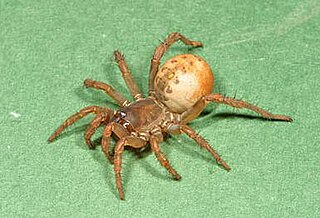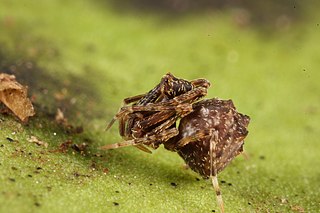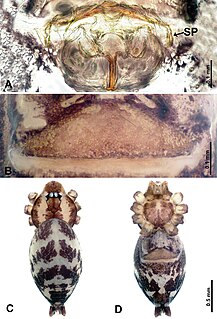
The family Dipluridae, known as curtain-web spiders are a group of spiders in the infraorder Mygalomorphae, that have two pairs of booklungs, and chelicerae (fangs) that move up and down in a stabbing motion. A number of genera, including that of the Sydney funnel-web spider (Atrax), used to be classified in this family but have now been moved to Hexathelidae.

The Mesothelae are a suborder of spiders that includes a single extant family, Liphistiidae, and a number of extinct families. This suborder is thought to form the sister group to all other living spiders, and to retain ancestral characters, such as a segmented abdomen with spinnerets in the middle and two pairs of book lungs. Members of Liphistiidae are medium to large spiders with eight eyes grouped on a tubercle. They are found only in China, Japan, and southeast Asia. The oldest known Mesothelae spiders are known from the Carboniferous, over 300 million years ago.

The spider family Liphistiidae, recognized by Tamerlan Thorell in 1869, comprises 8 genera and about 100 species of medium-sized spiders from Southeast Asia, China, and Japan. They are among the most basal living spiders, belonging to the suborder Mesothelae. In Japan, the Kimura spider is well known.
Araneida is a suborder for the order Araneae, suggested by Wunderlich in 2015. It includes all modern spiders, and excludes Uraraneida.

Ochyroceratidae is a six-eyed spider family, with 165 described species in ten genera. They are common inhabitants of caves and the tropical forest litter of South Africa, the Caribbean, Asia and South America. Considered an ecological counterpart of the Linyphiidae of the northern temperate zone, species are especially diverse in the Indo-Pacific region.

Tetrablemmidae, sometimes called armored spiders, is a family of tropical araneomorph spiders first described by Octavius Pickard-Cambridge in 1873. It contains 126 described species in 29 genera from southeast Asia, with a few that occur in Africa and Central and South America. Pacullidae was incorporated into this family in 1981, but was later restored as a separate family in a 2016 phylogenetic study.

Archaeidae, also known as assassin spiders and pelican spiders, is a spider family with about ninety described species in five genera. It contains small spiders, ranging from 2 to 8 millimetres long, that prey exclusively on other spiders. They are unusual in that they have "necks", ranging from long and slender to short and fat. The name "pelican spider" refers to these elongated jaws and necks used to catch their prey. Living species of Archaeidae occur in South Africa, Madagascar and Australia, with the sister family Mecysmaucheniidae occurring in southern South America and New Zealand.
Pacullidae is a family of araneomorph spiders first described by Eugène Simon in 1894. It was merged into Tetrablemmidae in 1958, then raised back to family status after a large phylogenetic study in 2017.
This list of fossil arthropods described in 2015 is a list of new taxa of trilobites, fossil insects, crustaceans, arachnids and other fossil arthropods of every kind that have been described during the year 2015. The list only includes taxa at the level of genus or species.

Archaea is an extinct genus of spiders in the family Archaeidae. As of October 2016, four species are placed in the genus. All have been found preserved in amber, either from the Baltic or Bitterfeld, Germany. First described in 1854, Archaea species have a distinctive "neck" separating the head from the thorax, and very long chelicerae ("jaws").
Burmesarchaea is a diverse extinct genus of spiders, placed in the family Archaeidae. The type species Burmesarchaea grimaldii was first described in 2003 and least 13 more species have been assigned to the genus. The genus has been exclusively found in Cretaceous Burmese amber, which is dated to 99 million years ago.
Leclercera is a genus of spiders in the family Psilodercidae found in southeast Asia, including Thailand, Nepal, and the Philippines. It was first described in 1995 by Christa L. Deeleman-Reinhold, who named it after a fellow collector of Asian spiders. She originally placed under Ochyroceratidae, but it was later moved it to Psilodercidae. It is named for Philippe Leclerc, a collector of spiders in southeast Asia.
This list of fossil arthropods described in 2012 is a list of new taxa of trilobites, fossil insects, crustaceans, arachnids and other fossil arthropods of every kind that have been described during the year 2012. The list only includes taxa at the level of genus or species.

Althepus is a genus of spiders in the family Psilodercidae. It was first described in 1898 by Tamerlan Thorell. As of 2019, it contains 60 species, all from Asia.
Althepus minimus is a species of spider of the genus Althepus.

Psilodercidae is a family of spiders first described as a subfamily of Ochyroceratidae by Machado in 1951 and raised to family rank by J. Wunderlich in 2008. These spiders can be distinguished by the "segestriid positioning" of their six eyes, the absence of leg bristles, strong apical bristles on the cymbium, and several pairs of spermathecae in females.
Burmese amber is fossil resin dating to the early Late Cretaceous Cenomanian age recovered from deposits in the Hukawng Valley of northern Myanmar. It is known for being one of the most diverse Cretaceous age amber paleobiotas, containing rich arthropod fossils, along with uncommon vertebrate fossils and even rare marine inclusions. A mostly complete list of all taxa described up until 2018 can be found in Ross 2018; its supplement Ross 2019b covers most of 2019.
Fossilcalcaridae is an extinct Mygalomorphae spider family in the clade Avicularioidea containing the single species Fossilcalcar praeteritus. The family genus and species were described in 2015 from a male fossil entombed in Cretaceous age Burmese amber.

Lagonomegopidae is an extinct family of spiders known from the Cretaceous period. Members of the family are distinguished by a large pair of eyes, positioned on the anterolateral flanks of the carapace, with the rest of the eyes being small. They have generally been considered members of Palpimanoidea, but this has recently been questioned. Members of the family are known from the late Early Cretaceous (Albian) to near the end of the Late Cretaceous (Campanian) of Eurasia, North America and the Middle East, which was then attached to Africa as part of Gondwana. They are generally assumed to have been free living hunters as opposed to web builders.









